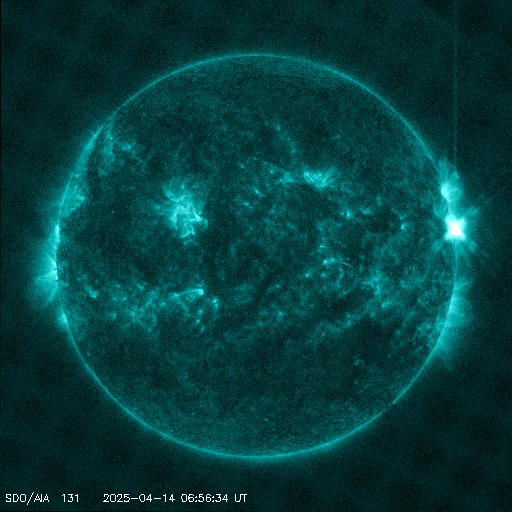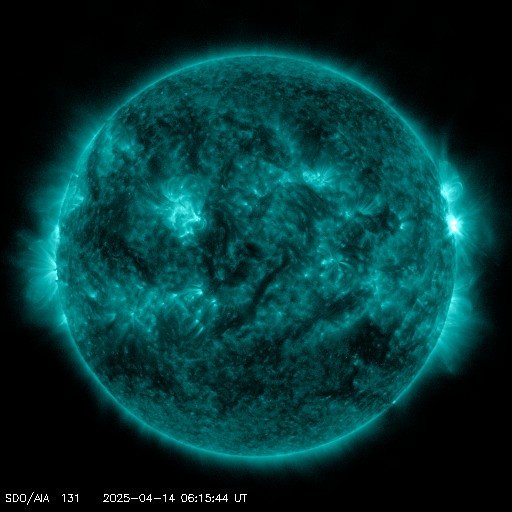Viewing archive of Monday, 6 July 2020
Daily bulletin on solar and geomagnetic activity from the SIDC
Issued: 2020 Jul 06 1231 UTC
SIDC Forecast
Solar flares
Quiet conditions (<50% probability of C-class flares)
Geomagnetism
Quiet (A<20 and K<4)
Solar protons
Quiet
| 10cm flux | Ap | |
|---|---|---|
| 06 Jul 2020 | 069 | 007 |
| 07 Jul 2020 | 068 | 004 |
| 08 Jul 2020 | 068 | 004 |
Bulletin
Solar activity was at very low levels and is expected to remain so. Small sunspot region NOAA 2766 is quiet and located near disk centre.
The greater than 10 MeV proton flux and the greater than 2 MeV electron flux were at nominal levels during the last 24 hours and are expected to remain so.
No earth-directed coronal mass ejections (CMEs) were observed in available coronagraphic imagery. The bulk of yesterday's CME (5 July) seems not to be earth directed and a glancing blow is unlikely.
The earth environment remained under the influence of an enhanced wind stream associated with an extension of the positive polarity northern polar coronal hole (CH). Solar wind speed varied between 500 and 430 km/s, ending the period near 490 km/s (DSCOVR). Bz varied between -6 and +5 nT. The direction of the interplanetary magnetic field (phi angle) was predominantly directed away from the Sun (positive sector).
Geomagnetic activity was at quiet to unsettled levels. Geomagnetic conditions are expected to be quiet, with a chance on an isolated unsettled interval during the ongoing period.
Today's estimated international sunspot number (ISN): 006, based on 27 stations.Solar indices for 05 Jul 2020
| Wolf number Catania | /// |
| 10cm solar flux | 069 |
| AK Chambon La Forêt | 014 |
| AK Wingst | 012 |
| Estimated Ap | 013 |
| Estimated international sunspot number | 005 - Based on 36 stations |
Noticeable events summary
| Day | Begin | Max | End | Loc | Strength | OP | 10cm | Catania/NOAA | Radio burst types | |
|---|---|---|---|---|---|---|---|---|---|---|
| None | ||||||||||
Provided by the Solar Influences Data analysis Center© - SIDC - Processed by SpaceWeatherLive
All times in UTC
Current data suggests there is a slight possibility for aurora to appear at the following high latitude regions in the near future
Edmonton, AB, Gillam, MB, Saskatoon, SK, Whitehorse, YT, Yellowknife, NTAnchorage, AK, Fairbanks, AK, Juneau, AK
Latest news
Latest forum messages
Support SpaceWeatherLive.com!
A lot of people come to SpaceWeatherLive to follow the Sun's activity or if there is aurora to be seen, but with more traffic comes higher server costs. Consider a donation if you enjoy SpaceWeatherLive so we can keep the website online!

Latest alerts
07:09 UTC - Solar flare
Moderate M4.28 flare from sunspot region 4055
06:48 UTC - Radio Blackout
Minor R1 radio blackout in progress (≥M1 - current: M1.53)
06:24 UTC - Solar flare
Moderate M1.49 flare from sunspot region 4055
06:06 UTC - Radio Blackout
Minor R1 radio blackout in progress (≥M1 - current: M1.16)
04:45 UTC - Geomagnetic activity
Active geomagnetic conditions (Kp4) Threshold Reached: 04:29 UTC
Space weather facts
| Last X-flare | 2025/03/28 | X1.1 |
| Last M-flare | 2025/04/14 | M1.4 |
| Last geomagnetic storm | 2025/04/06 | Kp5 (G1) |
| Spotless days | |
|---|---|
| Last spotless day | 2022/06/08 |
| Monthly mean Sunspot Number | |
|---|---|
| March 2025 | 134.2 -20.4 |
| April 2025 | 132.1 -2.1 |
| Last 30 days | 132.4 -10.7 |





